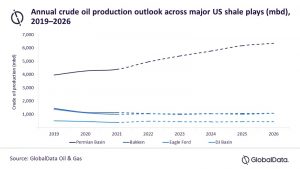U.S. crude oil production grew steadily in 2022 thanks to increased energy demand in the United States and internationally. GlobalData noted that the majority of this production has been conducted in the Lower 48 (L48) region, which represented nearly three-fourths of total production. The data and analytics company notes that this upward swing is expected to continue in the medium term following sustained investment in the area.
The major oil plays within the L48 region include the Permian, Bakken, Eagle Ford, and DJ basins. Together, they were expected to cumulatively produce around 7.5 million barrels per day (mmbd) of crude oil in 2022.
Ravindra Puranik, Oil and Gas Analyst at GlobalData, comments: “The Permian Basin benefits from well-developed infrastructure and is close to the refining and crude export terminals at the Gulf Coast. These, combined with strong investment and a powerhouse workforce, will help the basin achieve an estimated production of 5.0 mmbd in 2022.”
Aside from a few brief phases of downturn in 2020 and 2021, gas production in the U.S. shales has largely maintained an upward trend since 2018.
Puranik adds: “Growing domestic energy demand in 2022 amid sustained economic recovery from the pandemic is expected to support steady growth in gas production across the US L48. Additionally, the Russia-Ukraine conflict has prompted European gas importers to seek alternatives to Russian gas, further prompting US gas producers to lift their output.”
As per GlobalData estimates, the biggest contribution to U.S. natural gas production growth is expected to come from the Marcellus and Permian resource plays. Marcellus, the largest natural gas formation in the country, contributed nearly one-third of the U.S. unconventional gas output in 2021.
Puranik concludes: “Currently, shale oil and gas producers are primarily focusing on maximizing value for their shareholders. This is in stark contrast to the previous oil price downturn during the 2014-16 period, when companies kept adding drilling and completion crews to drive output. The current scenario is reflected in the number of rigs, which are still below pre-pandemic levels. This indicates that operators are following a measured approach at capital spending and production growth, despite the recent surge in oil prices.”











